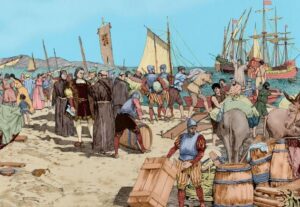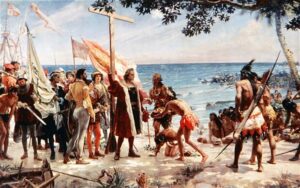The late 15th century witnessed an unprecedented exchange of plants, animals, and cultures between the Old World and the New World, a phenomenon now known as the Columbian Exchange.
Initiated by Christopher Columbus’s voyages, this transformative interchange had profound and lasting effects on societies and ecosystems on both sides of the Atlantic.
In this article, we embark on a journey through the Columbian Exchange, exploring its historical context, key components, and the enduring impact it had on the course of human history.
I. Columbian Exchange: The Origins and Exploration

Columbian Exchange
1.1 Columbus’s Voyages:
The Columbian Exchange takes its name from Christopher Columbus, the Genoan explorer whose voyages in the late 15th century opened the floodgates of global exchange. In 1492, Columbus reached the Americas, unintentionally paving the way for an unprecedented mingling of Old World and New World elements.
1.2 Components of Exchange:
The Columbian Exchange involved the transfer of a vast array of goods and organisms between the Eastern and Western Hemispheres. Key elements included crops, livestock, diseases, and cultural practices. This exchange fundamentally altered the biological, cultural, and economic landscapes on both sides of the Atlantic.
1.3 Columbian Exchange – The Impact of Exploration:
Columbus’s voyages initiated a new era of exploration and interaction between Europe, Africa, and the Americas. The establishment of transatlantic trade routes connected distant continents, facilitating the exchange of commodities, ideas, and technologies. However, this interchange also brought about unintended consequences, such as the introduction of devastating diseases to previously isolated populations.
II. Columbian Exchange: Flora and Fauna Across Continents

Christopher Columbus
2.1 Agricultural Exchange:
One of the most significant aspects of the Columbian Exchange was the transfer of crops that transformed agriculture on both sides of the Atlantic. Old World staples like wheat, rice, and grapes found their way to the Americas, while New World treasures such as maize, potatoes, and tomatoes revolutionized European diets. This cross-fertilization of crops laid the foundation for diverse and sustainable agricultural practices.
2.2 Columbian Exchange – Livestock and Domestication:
Livestock played a pivotal role in the Columbian Exchange, with Europeans introducing horses, cattle, and pigs to the Americas. These animals, previously unknown in the New World, became integral to indigenous societies, affecting hunting practices, transportation, and the development of pastoral economies. Conversely, the Americas contributed llamas, alpacas, and turkeys to the Old World, enriching the global tapestry of domesticated animals.
2.3 Ecological Impact:
The Columbian Exchange had profound ecological consequences, creating new ecosystems by reshuffling species across continents. While some species thrived in their new environments, others struggled or became invasive. This unintentional ecological experiment forever altered landscapes, contributing to the ongoing debate about the anthropogenic impact on biodiversity.
III. Columbian Exchange: Societal and Cultural Transformations

Columbian Exchange Impact
3.1 Cultural Exchange:
The Columbian Exchange was not limited to the transfer of biological entities; it also facilitated a profound exchange of ideas, beliefs, and cultural practices. Europeans encountered indigenous cultures with rich traditions and unique perspectives, leading to a complex intermingling of traditions, languages, and customs. This cultural fusion shaped the identity of societies on both sides of the Atlantic.
3.2 Columbian Exchange – Impact on Indigenous Populations:
While the Columbian Exchange brought new opportunities and resources to the Old World, it also brought devastation to the indigenous populations of the Americas. The introduction of Old World diseases, such as smallpox, measles, and influenza, decimated native communities that had no prior exposure or immunity. This demographic collapse had far-reaching consequences on social structures, leaving a lasting impact on the course of American history.
3.3 Economic and Social Repercussions:
The Columbian Exchange had profound economic implications, fuelling the rise of mercantilism and global trade networks. The influx of precious metals from the Americas enriched European economies, while the demand for labour in the New World led to the transatlantic slave trade. The economic transformations set in motion during this period laid the groundwork for the modern global economy.
The Columbian Exchange – Conclusion:
In conclusion, the Columbian Exchange stands as a pivotal chapter in human history, a narrative of interconnectedness and transformation that transcended geographical boundaries.
The exchange of flora, fauna, and cultures in the late 15th century laid the groundwork for the modern globalized world, shaping societies, economies, and ecosystems in ways that continue to resonate today.
As we reflect on this epochal exchange, it is essential to acknowledge the complexity of its impact, recognizing both the opportunities and challenges it presented to the diverse peoples involved.
The Columbian Exchange was a tapestry of change, woven by the threads of exploration, innovation, and unintended consequences.










